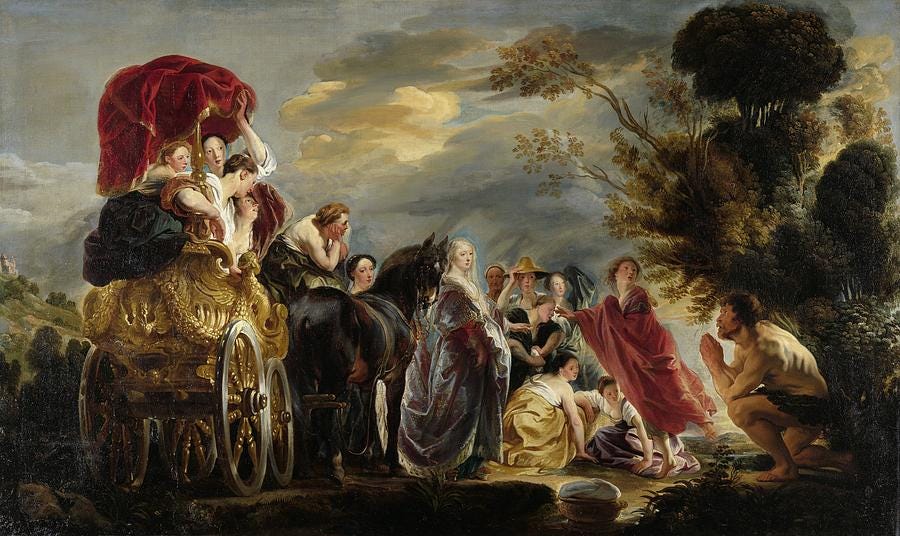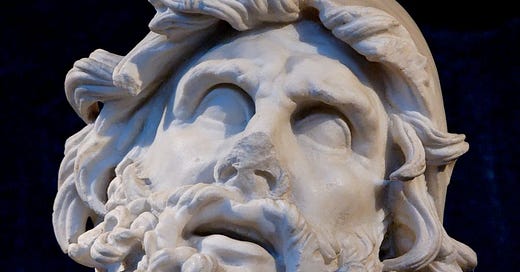Clarke, Howard. The Art of the Odyssey. Englewood Cliffs, NJ: Prentice-Hall, Inc., 1967.
Dr. Howard Clarke taught the classics at multiple universities in the United States, and, after retiring, continued to lecture on the great books from the comfort of a cruise ship in the Mediterranean. He passed away in 2015, shortly after I first encountered this little treatise. In The Art of the Odyssey, Clarke sets out to show that the Homeric story of Odysseus is not haphazard nor cobbled together. Rather, he establishes “the sophistication of Homer as an artist” while also rejecting “the hearty Philistinism that views the Odyssey as no more than a rattling good collection of sailors’ yarns” (2).
Clarke divides his topic into five short sections, followed by three helpful appendices, his brief endnotes, and a decent index. The major sections align with his overall argument that a note of artistry is to be found in the construction of the Odyssey.
Part One deals primarily with Book I of Homer’s epic, particularly the poetic introduction in the first lines of the book. From this section, Clarke points out the distinction between the Iliad and the Odyssey, which is namely an issue of justice. Achilles’ story is one of injustice, committed by both “powerful men and the gods,” while Odysseus’ journey tells how “a good hero defeats evil men” and the gods act accordingly (7). For Clarke, Homer’s concern for justice motivates the construction of the poem.
Part Two explores Telemachus’ character and journey. As the son of Odysseus, Telemachus lacks a proper education into manhood, but what he “experiences is not something taught, but something imparted––one young man’s initiation into a world he has inherited and whose values he will soon have to defend by force” (43). Clarke gives importance to Telemachus in a way I had not previously encountered in Homeric scholarship. Telemachus’ story is a sad one but also one perennially related to the present according to Clarke’s argument.
Part Three deals with Odysseus’s various wanderings and notes particularly the way Odysseus interacts with women throughout the story. This is perhaps where Odysseus finds the most criticism today, with the popular trend of retelling Greek stories from the perspective of women often painting a negative picture of the Ithacan king.1 The transition from Parts Three to Four hang on the treatment of women, and Clarke argues that Homer’s portrayal of women in the Odyssey is evidence that “whatever Homer has touched he has transformed and humanized, and the spirit of his poetry is far removed from the props of rite and the quirks of myth” (71).
Thus, in Clarke’s analysis of Odysseus’ return of home the reader can see how “Homer has achieved the ultimate end of all art, perfect fusion of form and content” (72). Even the details of the cleansing process after the suitors have been defeated contains echoes of sacrificial and liturgical elements that find resonance in the New Testament. Clarke sees Homer’s violent hero as ritualistically cleaned, and all of this is accomplished through Homer’s poetic structure.
Part Five wraps up the book with some final comparisons between the Iliad and the Odyssey, noting especially how Hektor, Achilles, and Odysseus all differ in terms of values, and the significance that gives the stories.

Clarke puts forward the idea that Odysseus is a good man. It is not enough to say he was an ideal Greek man, in this sense, for Virgil and Dante would clearly take issue with their great disdain for the cleverest of the Greeks.2 But, if Clarke is right, Homer’s art weaves a tale wherein the hero, frequently finding himself in difficult spots and dangerous company, resorts to lies to accomplish his goal. This is not to be confused with the trickster gods Loki or Hermes, who tell lies for the fun of it, but fits in with a theme of the Odyssey, that “truth must be learned by suffering” (25). Though not the only important idea proposed by Clarke, this adds a moral dimension to the story that gives ethical depth to Odysseus. This is something that is affirmed in the Bible as well (i.e. Job or Ecclesiastes) and provides good discussion fodder when reading through the book as a group. It is also characteristic of Clarke’s book, where a theme often overlooked is brought to light through an analysis of the Homeric art.

Perhaps the best example of Clarke’s analysis comes from Odysseus’ encounter with Nausicaa. This short scene takes up all 330ish lines of Book VI. Finding himself naked and weary on an unknown beach, Homer’s hero ends up in a comedic situation; his first human encounter is with a group of young women playing on the shore. A strong warrior like Odysseus could easily overwhelm these girls and ransom what he needs from the local town. Or he could rob them and be on his way, knowing that there would be little chance they could resist him. But Odysseus instead places himself at their mercy. He chooses gentility in requesting their aid and delivers one of the more memorable speeches in the story. As a result, Nausicaa sees beyond his grizzled and strange appearance. Clarke notes, “A general who can keep the troops waiting near a shrine while he admires a sapling is truly a soldier with a soul. If any speech at all is possible for a naked hero in front of a young girl, then Odysseus has made it” (53). Clarke recognizes the awkward situation for what it is, but he also sees how Homer crafts a character of great depth and virtue out of moments like this one.
Clarke’s brief book is an excellent guide to a Great Book. It avoids the pitfalls of lengthy, burdensome scholarship while shining light on the text as only someone who loves the story could do.
Madeline Miller’s Circe and Emily Wilson’s translation of The Odyssey both come to mind. Reviews critical of these works were often relegated to “mansplaining” or some other derogation. This tweet exemplifies the sort of responses common today regarding Odysseus and heroism: https://twitter.com/tlecaque/status/1695823865891475836.
Virgil’s Aeneid shows Odysseus to be a monster of a man, both during the sack of Troy and after his escape from the island of the Cyclopes (Books II and III). Dante follows his guide on this point, placing Odysseus in the place of evil counselors within the Inferno, Canto XXXVI. Though it is fair to say Dante sees Odysseus as a tragic, rather than hateful, figure.






I'll have to give it look!